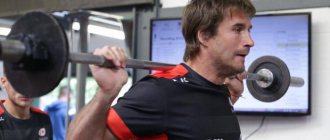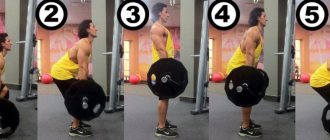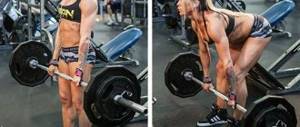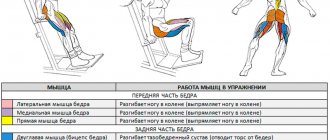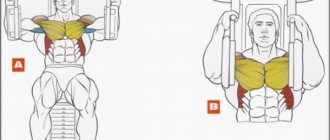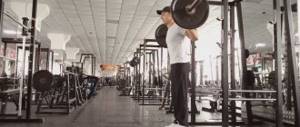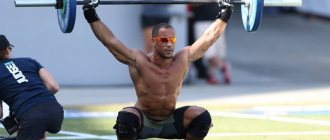Bent-overs with a barbell on the shoulders are an exercise for training the lower back (spine erectors) in isolation from other muscles; in addition, the leg muscles are involved: the gluteal and biceps. This exercise is also called GOOD MORNING for its similarity to bowing during a greeting.
The main factor that played a role in the formation of the second name - Good morning, was the principle of reproducing movements during bending forward with a barbell. Similar to bowing when greeting, they are very valuable in training the lower back, buttocks, hamstrings, and indirectly the abs.
Effect on muscles
The main load when performing bends with a barbell falls on the back muscles, namely the spinal extensors. These muscles run along the entire spinal column, they support the back in the correct position. The gluteus maximus muscles also work (raise the body from an inclination), the hamstrings (participate in raising the body, fix the position of the knees), semitendinosus and semimembranosus muscles.
The exercise uses the muscles of the back, buttocks and back of the thighs.
This exercise is not recommended for beginners. It is well suited for athletes with average and high levels of training.
What muscles work
When bending over with a barbell on your shoulders, the main work of lifting the body to the starting position is performed by:
- Gluteal muscles. This includes the three gluteal muscles: maximus, medius and minimus. In order to use them as much as possible, you need to slightly bend your legs at the knee joint.
- Muscles of the back of the thigh. These include the biceps, semimembranosus, and semitendinosus muscles. They, together with the buttocks, are responsible for hip extension. If you bend over with straight legs, these muscles will take most of the load.
The benefits of doing the exercise
There are a number of positive effects that can be an argument for adding exercise to your training program.
- Strengthening the back muscles, which, together with the development of the gluteal muscles, gives a serious advantage when performing basic exercises.
- Impact on the muscles of the back surface of the body, in the absence of load on the quadriceps.
- When performing the exercise from a standing position, the back surface of the legs receives a fairly good stretch. If you do bends while sitting, the load is more isolated.
- Improved posture. It is possible to use exercises to recover from injuries (after consultation with a doctor).
How can you replace the exercise: variations and alternatives
There are several variations of the classic design of the element. The most famous is bending forward with a barbell on your shoulders from a sitting position. The execution technique will be as follows:
- We sit on the edge of a bench with a barbell. The back should also be flat with a natural arch in the lower back. The distance between the feet should be slightly greater than when performing the element from a standing position.
- Slowly tilt the body forward to a level at which the position of the body remains unchanged. You won't be able to bend down until it's parallel to the floor.
- We return to the starting position.
The peculiarity of the technique is that the muscles of the back of the thighs are excluded from the work and the load on the spine increases.
The element can also be performed in a Smith machine or with a straight leg placed forward.
As for replacement, alternative exercises can be:
- deadlift;
- deadlift;
- hyperextension on a fitball;
- plie squat with a load.
Contraindications
Despite all the benefits, bending over with a barbell on your shoulders has a reputation as a traumatic exercise. However, this is the difference between almost all exercises performed with weights. If we highlight the main causes of injuries during strength training, there are only two of them:
- Too much weight, not suitable for the athlete.
- Violation of technology.
Improperly performing bends with a barbell on your shoulders does create a risk of injury. The lumbar spine may be affected first.
To minimize the risks during training, an athlete needs to honestly assess his physical fitness before performing an exercise.
- If you have problems with your back (in particular, with the lower back), it is better to refrain from bending over with a barbell on your shoulders. Any chronic pain in the lumbar region will only get worse under stress.
- In terms of difficulty, barbell bending is a fairly advanced workout that requires an understanding of body mechanics and muscle control. Therefore, start with light weights and gradually increase the load.
- Another important contraindication is a weak core. The exercise does not pump up the torso, but strong core muscles are necessary to keep the back straight.
Despite the name “good morning”, it is not recommended to perform the exercise during your morning workout. After sleep, our hydrophilic intervertebral cartilage fills with water. They are like liquid balloons ready to burst. The discs support your body weight and gradually compress throughout the day. But if you immediately load them with a barbell, the pressure may be excessive and there is a risk of injury. Therefore, perform the “good morning” exercise at least 2-3 hours after sleep, because your health is in your hands.
To work your major muscle groups, you need to include barbell exercises in your workout plan. They simultaneously “pump up” almost the entire body, promoting the growth of muscle mass and volume. If you want to have a beautiful back and hips, we recommend that you regularly perform bends with a barbell on your shoulders. Thanks to it, your body will be fit, proportional and strong.
Bent-overs with a barbell on the shoulders: what muscles are we “pumping up”?
First of all, let's decide whether this exercise is really necessary for you. You may need to work on your chest or arms, but your back and hips are doing just fine. When performing bends with a barbell, you work the muscles of the buttocks - both large and small. In addition to the hips, the back and abs are worked out. As you can see, the exercise helps increase endurance and strength in important muscle groups. By doing it regularly, you will notice that other exercises are now much easier for you.
What are the benefits of forward bends with a barbell:
- Increases the endurance of the back muscles;
- Pumps up the gluteal muscles;
- Improves stretching;
- Improves posture;
- Strengthens the abdominal muscles.
Who should not do this exercise? Since it involves the back muscles, the exercise is considered traumatic. It should not be performed by those who have back problems, in such cases it only aggravates the situation.
You might be interested in learning how to perform the Bulgarian lunge exercise correctly.
What weight should I use?
Bent-overs with a barbell do not involve the use of a lot of weight. Its essence is to work the muscles as deeply as possible and avoid injury. That is why you should not take the maximum weight - for example, about 30% of the weight that you use when doing squats. All movements are slow, measured and smooth.
It is better to perform inclines the first few times with an empty bar. This way you can master the technique without getting injured. Then gradually increase the weight.
Forward bends with a barbell on the shoulders: technique of execution
It is recommended to perform this exercise on the day you train your back, both at the beginning and at the end of working out this muscle group. Before bending, be sure to do a 10-minute warm-up; under no circumstances skip this stage.
How should the bar be positioned? When performed correctly, the bar should be placed on the trapezius muscles. You should not put the barbell on your neck, as this can cause a serious sprain. Also be sure to watch your back, it should be straight, do not lower your head.
Well, let's get started! Place your feet wide, shoulder width apart. The bar is located on the trapezius, and not on the neck; we hold it with our hands. The back is straight and tense, with a slight arch in the lumbar region.
Bend your knees slightly, this will make it easier to perform bends, now slowly tilt your torso forward. Ultimately, the torso should be parallel to the floor, neither lower nor higher. We keep the hips and knees in the same position, the pelvis is only slightly moved back.
When you have bent to the desired point, return to the starting position. At the same time, we continue to control our back, do not relax and bend it.
How many sets and reps? Like other barbell exercises, you need to complete three or four sets, with 10-12 reps being enough.
Bent-overs with a barbell while sitting: how to do them?
We place the barbell on the trapezius muscles and sit on the edge of the bench. The back bends in the lower back, the shoulders are straightened, the chest looks forward. Feet rest on the floor, shoulder-width apart or even a little wider.
We lean forward in the same pattern until you can do it and still hold your back. When you feel that you can’t bend any lower, return to the starting position.
Is there an alternative?
If for some reason you cannot perform bending exercises, you can replace them with other exercises that involve the same muscle groups. Alternative options are deadlifts, hyperextensions, and plie squats.
Now you know how to properly perform barbell curls. Now all that remains is to watch the video and see with your own eyes the technique of execution. Good luck!
Men's magazine Mensweekly.ru
Bend technique
In order to practice the technique, you can use the lightest weight or train with a bar. The starting position looks like this:
- Place your feet shoulder-width apart and grab a barbell. The bar should rest on your trapezius, just below your neck. Stand up straight, tense your back, maintaining a natural arch in your lower back. The back and lower back should be toned throughout the entire approach. In particular, you should not “loose” your back at the lowest point of the amplitude when the body is tilted forward.
- Straighten your shoulders and bend your knees slightly. Only trained athletes with good leg stretching and great mobility in the hip joints can perform forward bends with a barbell on straight legs.
Correct technique and appropriate weight will protect your lower back from injury.
Performing the exercise:
- Maintaining your back position (flat back, natural arch in the lower back), slowly lean your body forward until it is parallel to the floor. Movement occurs only in the hip joint, the pelvis is retracted back.
- From parallel to the floor, return the body to its original position using the force of the gluteal muscles and hips. The back does not round or relax.
- Repeat as many times as necessary.
It is important to note that the depth of the bend when performing the exercise while standing depends on the flexibility of the hamstrings. Don't risk trying to go deeper than your stretch allows.
Bends while sitting on a bench
Let's also consider the option of bending over with a barbell from a sitting position. In general, the technique remains the same, but the muscles of the back of the thighs are turned off from the work. Plus, with this starting position, the load on the spine increases.
Variation of the exercise while sitting on a bench.
- To perform the exercise, you need to take a barbell and sit with it on the edge of a bench. Hold the barbell below your neck on the trapezius, your back is straight, there is a natural arch in your lower back, your chest and shoulders are open. Place your feet on the floor in front of you, pointing your toes slightly to the sides. The distance between the legs will be slightly greater than when performing standing bends.
- Slowly and in a controlled manner, lean forward until you can maintain the same position of your back. While sitting, you will not be able to bend down until it is parallel to the floor.
- Return to the starting position.
Bend-overs with a barbell on your shoulders while standing or sitting are recommended to be done 8-10 times in 3-4 approaches, or as recommended by the trainer. It is better to combine it with basic exercises, such as deadlifts.
As a rule, the weight chosen is no more than 20-30% of the weight used in barbell squats. However, here it is better to take less, but do it right.
How can you replace bending over with a barbell on your shoulders?
Variations of slopes are even less common than the classic version of the execution. Let's look at the two most common options.
Bent-overs with a barbell on your shoulders while sitting
This option is used by weightlifters in training. They do this to place a tighter load on the lower back and buttocks. And the muscles of the back of the thigh should be completely excluded from work. We also get an additional point of support. This will give us more stability and allow us to increase the weight of the barbell. But this will reduce your range of motion. Of course, if you squat seriously, bend over and add a series of muscle stretching exercises. Over time, you will be able to lower your chest almost to touch on the bench. At the same time with a straight back. But it is worth considering that when performing this option, it is very easy to get injured. So unless you plan to lift weights professionally, this shouldn't make your life too difficult. And a better option would be classic bends with a barbell on your shoulders while standing.
Bent-overs with a barbell on a Smith machine
This option is most often performed by girls. When performing exercises in the Smith machine, the gluteal muscles work well. However, you need to remember that in this simulator the movement follows a certain vector. This puts us in a not entirely advantageous position. And with the wrong technique, there is a very large load on the spine. In order for us to tip over, we must put our feet forward a little. The technique remains the same as in the classic version.
Share link:
Rate this article
Technique for performing the element to create the correct physical activity
To practice the exercise, use an empty bar or minimal weight. The athlete’s first priority is to master the correct movements, and only then is full physical activity on the muscles given.
Place your feet the width of the shoulder girdle, take the barbell, placing it on the trapezius muscles, slightly below the cervical region. The spine is straightened, the muscles are tensed during the entire exercise, especially at its lower point. Straighten your shoulders and slightly bend your lower limbs at the knee joints. Performing the element with straight legs requires a high level of stretching and mobility of the hip joints
This option cannot be performed without preparation. Leaving your back in a straight, tense position, carefully tilt your body forward until it forms a parallel line with the floor surface. The action is carried out through the hip joints, moving the buttocks back. Tightening the muscles of the buttocks and thighs, return to the starting position and repeat the exercise the required number of times.
To perform it safely, you should not immediately do deep bends; you must remember that the range of movements depends on the elasticity of the hamstrings.
An option for performing the element is bending over with a barbell in a sitting position:
- The barbell is placed on the trapezius muscles and sat on the edge of the bench. Straighten the thoracic and shoulder regions, straighten the spine, and maintain a physiological deflection in the lower back. Feet rest on the floor, toes point to the sides.
- They lower themselves down until it is possible to maintain a straight back. It will be impossible to lower yourself to a parallel line with the floor in this position.
- Return to the starting position.
Beginners in fitness training repeat this element 8-10 times, 3-5 sets. It is most effective when combined with basic exercises such as deadlifts or squats. The working weight should be no more than 20% of that used in barbell squats. Most often, bending is placed before complex basic elements, as they well prepare the muscles and joints for the upcoming work.
Useful tips
Bent-overs with a barbell must be performed correctly. This is why you need to use the strength of your hamstrings and gluteal muscles when lifting your body. The back at this moment should not straighten or round.
It is important to understand that the main muscle involved in working while standing with a barbell in your hands is the extensor spine. It must be constantly under tension, since its role is to ensure the natural curvature of the spinal column while bending. If a novice athlete has just started doing bends, then it is better to perform them at a slow pace and with an empty bar.
To protect your knees from damage, you need to squat slightly in the starting position . This will increase the stability of the legs and also allow the hip joint to better cope with the tilt of the body. “Good morning” with fully straightened legs can only be done by professional athletes with well-developed ligaments.
Correctly performed side bends with dumbbells will help develop the lateral abdominal muscles.
And if you want to learn how to correctly perform body turns with a stick on your shoulders, read this: /silovye/press-i-kosye/kosye/vrashhenie-korpusa.html.
In addition to the hip joints, the muscles of the back of the thigh are well stretched during the exercise. This is why bending can be done before squats and lunges.
How to train with a barbell to gain muscle mass
The training process, designed to gain weight, should be divided into three to four workouts per week. For example, on the first training day, exercises are performed aimed at developing the chest muscles; it would also be a good idea to do several triceps exercises - a synergist for the pectoral muscles.
Each exercise should be performed in 3-4 approaches, not counting warm-up ones. The weight should be calculated so that you can perform 8 to 12 repetitions. Rest between sets should be about two minutes. Below we will present a detailed complex with a barbell for gaining weight at home.
How to work until the result
Women do not need to spend a lot of time to develop biceps and triceps. When doing presses and push-ups, the triceps muscles are simultaneously loaded. If the complex includes rows for the back, the biceps are partially worked out. Therefore, it is enough for girls to purposefully pump their arms in the gym once a week.
The set of arm exercises is based on 2 basic techniques - lifting and extension, and their modifications. The heavier the dumbbells in your hands, the faster the muscle fibers increase in volume. Training with 2 kg equipment, even despite numerous repetitions, will not give any effect. So, without a doubt, grab some heavy dumbbells or a barbell and do 12 reps for 3 sets, resting 30 seconds between sets.
